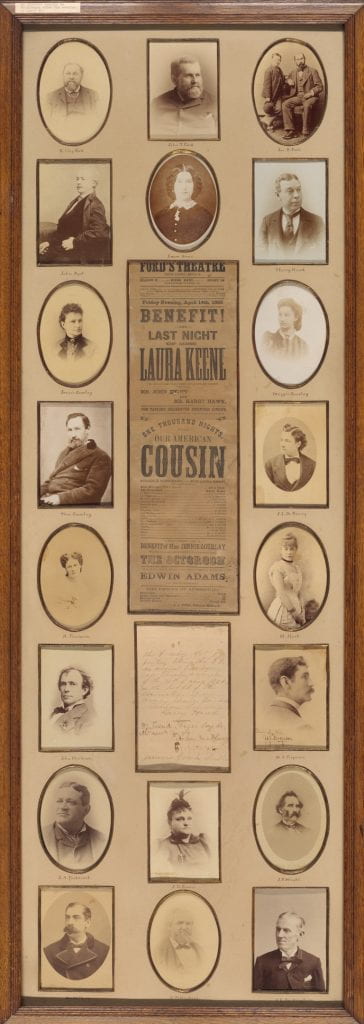By Matthew Wittmann, Curator of the Harvard Theatre Collection

Rather unfortunately, an evening performance of Our American Cousin at Ford’s Theatre on April 14, 1865 is perhaps the most remarked upon theatrical event in American history. Harry Hawk, who played the “cousin” character Asa Trenchard, delivered this risible line in Act II: “Don’t know the manners of good society, eh? Well, I guess I know enough to turn you inside out, old gal — you sockdologizing old man-trap.” John Wilkes Booth ostensibly hoped that the ensuing laughter would cover the sound of his gun, and shot the President as he enjoyed a hearty laugh at the scene. Lincoln slumped forward as Booth jumped onstage and made a dramatic escape from the theatre. Although he survived the night, the wound was mortal and Lincoln passed away a little after seven the following morning. In the wake of the President’s shocking death, the public evinced a strong desire for mementos and playbills for the infamous performance proved to be one particularly valued keepsake. Years later and in a similar spirit, Harry Hawk assembled a montage of photographs and documents memorializing the tragic evening.

Although the portraits are mostly of theatrical professionals connected to the performance, Henry Polkinhorn, owner of the print shop printer used by Ford’s Theatre is also pictured in the middle of the bottom row. The letter at center by Hawk testifies that the playbill above is an original April 14 bill, but it was in fact printed soon after the fact by Polkinhorn, the giveaway being the broken “E” in the line dedicated to Laura Keene.

Indeed, authentic original playbills for the April 14 performance are few and far between amidst the ensuing flood of reproductions. The Harvard Theatre Collection holds a remarkable bound volume of playbills for the 1864-65 season at Ford’s Theatre that was assembled by stage manager John B. Wright. A letter tipped in to the front of the volume explains that there were actually two different issues of the playbill printed on April 14. When Wright was advised of the President’s patronage that morning, he went to Polkinhorn’s shop to have the lyrics for a patriotic song, “Honor to Our Soldiers,” added to the bill. When he arrived, the first version was already in the process of being printed. The press was stopped and the necessary changes to the form were made so that the remainder of the bills were printed with the added stanza. Wright took all of the bills that had been printed with him back to the theatre so both versions were posted and distributed that fateful day. The Harvard Theatre Collection holds two examples of the first type and one of the second issue (below) with the additional “patriotic song and chorus.”


Note the fully formed last letter “E” in KEENE here in the original, which stands in stark contrast to the broken top beak of the “E” so commonly found in later reproductions. For whatever reason, when Polkinhorn began reprinting the playbills as souvenirs in the days after the assassination he printed the first issue lacking the stanza rather than the second issue. These initial reprints with the broken “E” and later reproductions of the same are the ones so often confused with the true original playbill. Polkinhorn’s choice essentially saved the second issue from the same confusion. For a full exploration and analysis of the rather convoluted history of this fascinating bit of Americana, see Walter Brenner’s study, to which this post is much indebted.
This post originally appeared on April 15, 2017 in entr’acte, Harvard Theatre Collection’s blog, no longer in publication.
